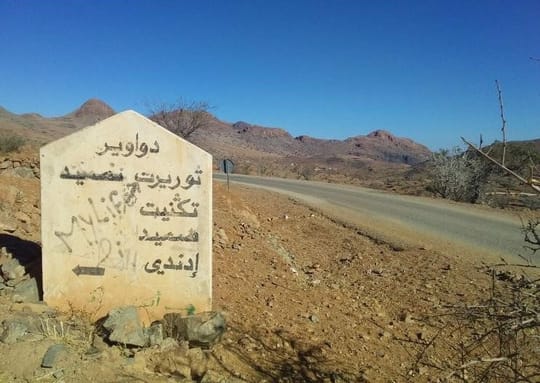My Journey to Tisfane

By Jamal Maghiouzi, Cultural Field Coordinator
I left my village of Ait Kassi Ouali at 6:30 in the morning to travel the 90 kilometers to Ouarzazate in a grand taxi before taking another for about five hours to the outskirts of Taroudant. I traveled from Taroudant to Ait Iazza, and then finally from Ait Iaazza to Tisfane in a minibus that arrived there just after five in the evening. The weather was warm, and the sun had not yet set.

Some of Tisfane’s villages: Taourirte n Cimid, Tagounite, Cimid, Idindi. November 2021.
Photo: Jamal Maghiouzi/HAF
Upon arrival, an arranged contact received me warmly, generously opening his home to me after my many hours of travel and modes of transportation. That evening, he spoke of many ideas with excitement and energy, including how pleased he was for my arrival and upcoming work. The High Atlas Foundation (HAF) has ongoing projects in Tisfane, and members of the USAID Religious and Ethnic Minorities Activity (REMA) team had previously visited the area, learning of its cultural richness. This moment, however, was the first visit by the REMA field team. As a new cultural field coordinator, I had just arrived to begin an extended stay in the region to listen to the stories and histories of those living there in an effort to help keep their memories alive.
Tisfane is remote and very beautiful. The rocky mountains fill the village with sand-colored geography that glows pink in the sun but also serves as a reminder of how years of drought have impacted the area. My host explained some of the challenges for those living in Tisfane, where there is no well or water source, and travel to the nearest village is required for water retrieval.
Finding accommodation in Tisfane is not an easy task, and I am not the first from HAF to look for it. That first evening, I was introduced to others in the village and shared a meal while exchanging our various backgrounds together. One man from the village knew my home province of Tinghir quite well, having worked in the Taouzzagte mine as a driver until 2007. Knowing the challenges of searching for housing, he also invited me to his home until I had found a permanent solution.

Terraced mountains in Tisfane. November 2021. Photo: Jamal Maghiouzi
Another acquaintance I made that evening was a man who made Amazigh slippers, idouçan or belgha, in the region. He spoke at length about the region’s issues with droughts and the challenges that Tisfane has faced because of this. Earnestly, he shared the problems associated with agriculture and the past failed attempts resulting in the loss of precious trees. The number of thirsty, lifeless almond trees is difficult to ignore.

Traditional millstones for making Amlou and olive oil in Taroudant. November 2021. Photo: Jamal Maghiouzi
The new acquaintance I met that day turned out to be my eventual landlord, and – I’m glad to also say – a new friend. We often share meals, and our shared Moroccan culture always surfaces in one way or another. This first meeting was over a meal but quickly progressed into a discussion about amlou, a Moroccan spread made most often with roasted almonds and Argan oil. Amlou is a must-have if you are hosted by an Amazigh family in the Souss-Massa region. Now, whenever I have to make the trip from Ait Iazza to Taroudant, I bring him almonds, which his mother uses to prepare amlou. Over meals with this rich staple and wood-baked bread, and with each of the local community members I’ve met in my first days here, I am embracing my work as a field coordinator and diving into REMA’s goals of preserving Morocco’s diverse cultural history.
Jamal Maghiouzi is a Cultural Field Coordinator for the (USAID) Religious and Ethnic Minorities Activity (REMA). He is currently based in the Taroudant province.
This article was completed with the support of the United States Agency for International Development, and the High Atlas Foundation is solely responsible for its content, which does not necessarily reflect the views of the USAID or the Government of the United States.